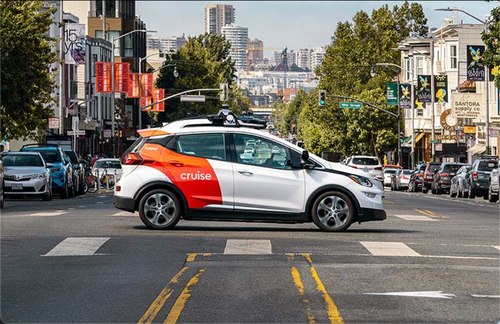
General Motors' autonomous car unit, Cruise, announced on X Thursday night that all its driverless car fleets nationwide will be halted after several collisions and a suspension of its license in California.
"The most important thing for us right now is to take steps to rebuild public trust. Part of this involves taking a hard look inwards and at how we do work at Cruise, even if it means doing things that are uncomfortable or difficult," Cruise wrote in a post.
(1/3) The most important thing for us right now is to take steps to rebuild public trust. Part of this involves taking a hard look inwards and at how we do work at Cruise, even if it means doing things that are uncomfortable or difficult.
— cruise (@Cruise) October 27, 2023
The San Francisco-based company continued, "In that spirit, we have decided to proactively pause driverless operations across all of our fleets while we take time to examine our processes, systems, and tools and reflect on how we can better operate in a way that will earn public trust."
(2/3) In that spirit, we have decided to proactively pause driverless operations across all of our fleets while we take time to examine our processes, systems, and tools and reflect on how we can better operate in a way that will earn public trust.
— cruise (@Cruise) October 27, 2023
Cruise explained that pausing its driverless car fleets was not "related to any new on-road incidents, and supervised AV operations will continue," adding, "We think it's the right thing to do during a period when we need to be extra vigilant when it comes to risk, relentlessly focused on safety, & taking steps to rebuild public trust."
(3/3) This isn't related to any new on-road incidents, and supervised AV operations will continue.
— cruise (@Cruise) October 27, 2023
We think it’s the right thing to do during a period when we need to be extra vigilant when it comes to risk, relentlessly focused on safety, & taking steps to rebuild public trust.
On Tuesday, the California Department of Motor Vehicles suspended Cruise's test permit for robotaxis, forcing each vehicle to have a human safety driver inside the cockpit if it wants to continue operating. This followed a collision with one of its vehicles earlier this month in downtown San Francisco.
CNBC provided more details about the robotaxi accident:
In one high-profile incident in early October, the human driver of another vehicle struck a pedestrian in San Francisco, launching her into the path of a Cruise self-driving car. According to DMV records obtained by CNBC, the Cruise autonomous vehicle came to a complete stop and "subsequently attempted to perform a pullover maneuver while the pedestrian was underneath the vehicle."
The DMV record said, "The AV traveled approximately 20 feet and reached a speed of 7 mph before coming to a subsequent and final stop," and "the pedestrian remained under the vehicle." The DMV wrote in its orders of suspension sent to Cruise, "the manufacturer's vehicles are not safe for the public's operation" and that they "may lack the ability to respond in a safe and appropriate manner during incidents involving a pedestrian."
Over the years, the claim has been that robotaxis would surpass human drivers in terms of safety. However, recent events suggest that this may not be the case (at least for now).
General Motors’ autonomous car unit, Cruise, announced on X Thursday night that all its driverless car fleets nationwide will be halted after several collisions and a suspension of its license in California.
“The most important thing for us right now is to take steps to rebuild public trust. Part of this involves taking a hard look inwards and at how we do work at Cruise, even if it means doing things that are uncomfortable or difficult,” Cruise wrote in a post.
(1/3) The most important thing for us right now is to take steps to rebuild public trust. Part of this involves taking a hard look inwards and at how we do work at Cruise, even if it means doing things that are uncomfortable or difficult.
— cruise (@Cruise) October 27, 2023
The San Francisco-based company continued, “In that spirit, we have decided to proactively pause driverless operations across all of our fleets while we take time to examine our processes, systems, and tools and reflect on how we can better operate in a way that will earn public trust.”
(2/3) In that spirit, we have decided to proactively pause driverless operations across all of our fleets while we take time to examine our processes, systems, and tools and reflect on how we can better operate in a way that will earn public trust.
— cruise (@Cruise) October 27, 2023
Cruise explained that pausing its driverless car fleets was not “related to any new on-road incidents, and supervised AV operations will continue,” adding, “We think it’s the right thing to do during a period when we need to be extra vigilant when it comes to risk, relentlessly focused on safety, & taking steps to rebuild public trust.”
(3/3) This isn’t related to any new on-road incidents, and supervised AV operations will continue.
We think it’s the right thing to do during a period when we need to be extra vigilant when it comes to risk, relentlessly focused on safety, & taking steps to rebuild public trust.
— cruise (@Cruise) October 27, 2023
On Tuesday, the California Department of Motor Vehicles suspended Cruise’s test permit for robotaxis, forcing each vehicle to have a human safety driver inside the cockpit if it wants to continue operating. This followed a collision with one of its vehicles earlier this month in downtown San Francisco.
CNBC provided more details about the robotaxi accident:
In one high-profile incident in early October, the human driver of another vehicle struck a pedestrian in San Francisco, launching her into the path of a Cruise self-driving car. According to DMV records obtained by CNBC, the Cruise autonomous vehicle came to a complete stop and “subsequently attempted to perform a pullover maneuver while the pedestrian was underneath the vehicle.”
The DMV record said, “The AV traveled approximately 20 feet and reached a speed of 7 mph before coming to a subsequent and final stop,” and “the pedestrian remained under the vehicle.” The DMV wrote in its orders of suspension sent to Cruise, “the manufacturer’s vehicles are not safe for the public’s operation” and that they “may lack the ability to respond in a safe and appropriate manner during incidents involving a pedestrian.”
Over the years, the claim has been that robotaxis would surpass human drivers in terms of safety. However, recent events suggest that this may not be the case (at least for now).
Loading…




